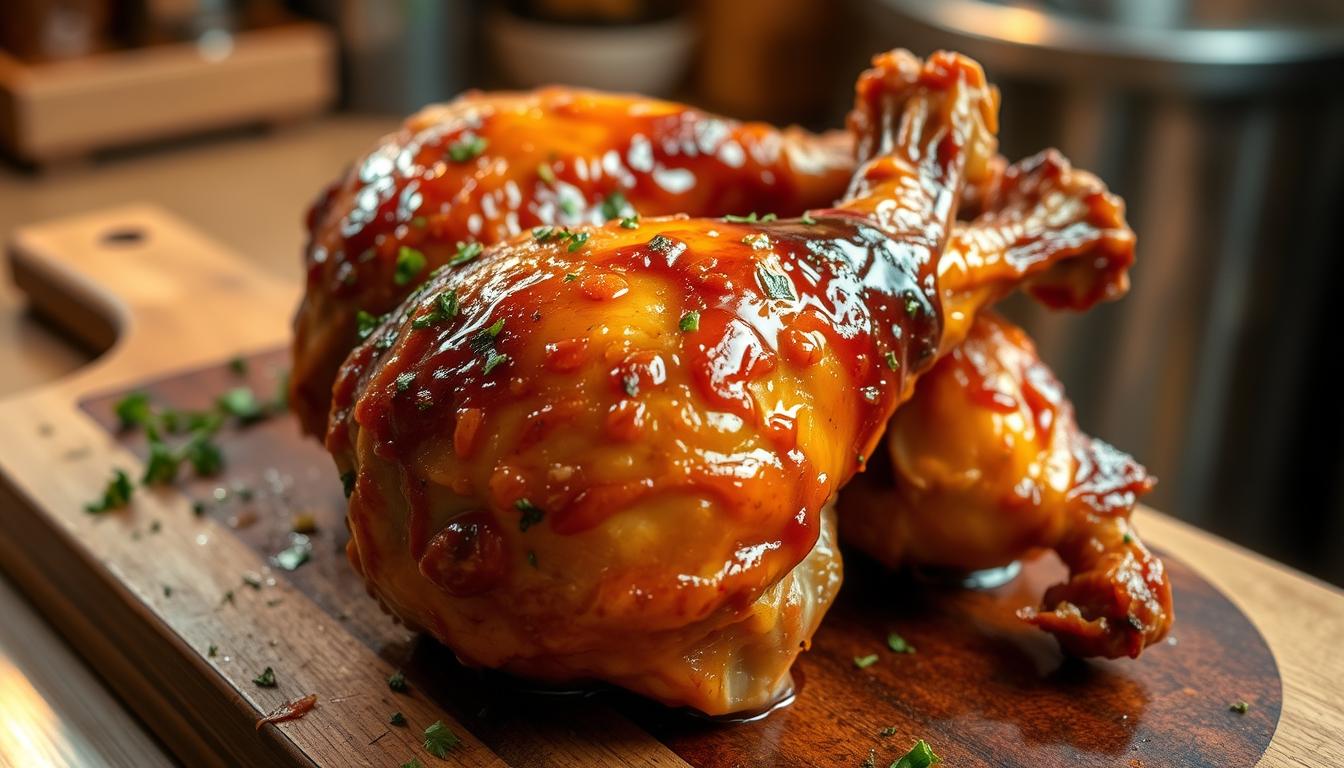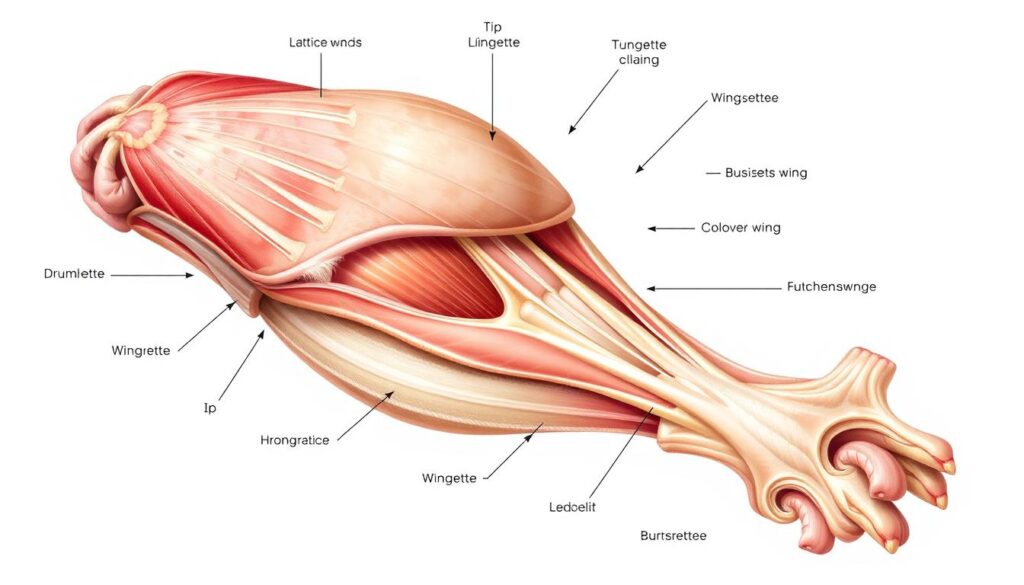Chicken wings are a favorite snack in America, loved by many. They’ve grown from simple food to a big hit in restaurants and homes. This guide will explore the full chicken wing, from its parts to the tasty sauces and seasonings that make it special.
Key Takeaways
- Discover the anatomy of a full chicken wing and the distinctive parts that make it a unique culinary experience.
- Explore the rich history and evolution of chicken wings, from their humble origins to their current status as a beloved American classic.
- Learn about the essential equipment and techniques required to achieve restaurant-quality wings at home.
- Dive into the world of sauces, dry rubs, and seasonings that elevate the flavor profile of chicken wings.
- Discover complementary side dishes and serving suggestions to create a well-rounded and satisfying meal.
Understanding the Anatomy of a Full Chicken Wing
A full chicken wing has three parts: the drumette, the flat (or wingette), and the wing tip. Each part has its own taste and cooking method. This makes each section special in its own way.
The Drumette Section
The drumette is like a mini-drumstick. It’s the meatiest part of the wing. Its shape and muscle make it perfect for high-heat cooking like frying, grilling, or baking.
When cooked right, the drumette juicy and tender. It gives a satisfying bite.
The Flat or Wingette
The flat, or wingette, is in the middle of the wing. It has two small bones and a thin layer of meat and skin. Its shape and texture work well with many cooking methods, from baking to glazing.
Its size makes it great for snacks and appetizers. It’s easy to eat with your fingers.
The Wing Tip
The wing tip is the smallest and most delicate part. It’s often thrown away or used in stocks. But, chefs have found ways to use it, like deep-frying it or adding it to dishes for looks.
Preparing the wing tip takes more effort. But, it adds a unique texture and look to your dish.
Knowing the differences in each part is key to cooking perfect chicken wing parts. Whether you’re making juicy drumettes, crispy wingettes, or creative wing tips, understanding each part helps.
| Chicken Wing Part | Characteristics | Ideal Cooking Methods |
|---|---|---|
| Drumette | Meatiest part, cylindrical shape | Frying, grilling, baking |
| Flat (Wingette) | Two small bones, thin layer of meat and skin | Baking, glazing, saucing |
| Wing Tip | Smallest and most delicate section | Deep-frying, stock-making, decorative plating |
The History and Evolution of Chicken Wings
The Buffalo wings have a rich history starting in 1964 at the Anchor Bar in Buffalo, New York. Teressa Bellissimo, the bar’s co-owner, created this beloved snack by accident.
Teressa was looking for a way to use leftover chicken wings. She fried them and mixed them in a sauce of Frank’s RedHot and melted butter. This tasty, messy snack quickly became a favorite at the bar.
The Buffalo wings were a huge hit, making the Anchor Bar famous. Over time, the wings have changed, with new flavors and cooking methods added. This has made them even more popular.
Now, Buffalo wings are everywhere in the U.S., with many variations. People love them for sports events, parties, and just because. They’re a favorite among many.
The story of the Buffalo wings shows how innovation can make something simple into a classic. It’s a story that keeps inspiring, making the chicken wing a true American favorite.
Essential Equipment for Perfect Wing Preparation
Cooking delicious chicken wings at home needs more than just the right ingredients. You also need the right kitchen tools. From deep fryers to temperature control devices, let’s look at the must-have tools for wing lovers.
Must-Have Kitchen Tools
Starting a wing kitchen right means having the right tools. A sturdy baking sheet or roasting pan is key for baking or air frying wings. A wing cooking equipment deep fryer makes wings crispy and golden. Tongs or forks make handling and serving wings easy.
Temperature Control Devices
Getting the perfect wing needs precise temperature control. A kitchen thermometer is essential to check the wings’ internal temperature. For deep-frying, a thermometer keeps the oil at the right temperature for crispy skin.
Storage and Serving Equipment
After cooking, you need the right tools to keep and serve your wings. Airtight containers or resealable bags are great for storing cooked wings. A large serving platter or basket is perfect for showing off your wings. Don’t forget about saucing and tossing tools, like a large bowl or tongs, to coat your wings evenly.
Investing in a good deep fryer and other kitchen tools will help you make wings like a pro. With the right temperature control and storage, your homemade wings will impress everyone and satisfy your cravings.
| Essential Wing Cooking Equipment | Benefits |
|---|---|
| Deep Fryer | Consistent temperature control, crispy skin |
| Baking Sheet/Roasting Pan | Even cooking, easy cleanup |
| Kitchen Thermometer | Accurate temperature monitoring, food safety |
| Tongs/Forks | Convenient handling and serving |
| Airtight Containers | Proper storage, extended freshness |
Selecting and Storing Fresh Chicken Wings
Enjoying the perfect fresh chicken wings starts with quality. Choosing the right wing quality and storing them properly are key. This ensures a flavorful and tender meal.
Choosing High-Quality Chicken Wings
To get the best fresh chicken wings, look for these traits:
- Bright, plump, and meaty appearance without any signs of discoloration or dryness
- Clean, fresh aroma without any off-putting odors
- Firm and springy texture when gently pressed
- Avoid wings that appear slimy, soggy, or have an unnatural color
Proper Storage for Freshness
After picking your fresh chicken wings, store them right. This keeps them fresh and safe from illness. Here are some storage tips:
- Refrigerate the wings immediately, ideally at a temperature between 34°F and 40°F (1°C and 4°C).
- Keep the wings in their original packaging or in a resealable plastic bag, squeezing out as much air as possible.
- Use the wings within 1-2 days of purchase for optimal freshness and safety.
- If freezing, wrap the wings tightly in plastic wrap or aluminum foil and store them at 0°F (-18°C) or below for up to 12 months.
By following these tips, you’ll enjoy the most flavorful and high-quality wings every time.
Popular Cooking Methods for Full Wings
Home cooks have many ways to make tasty full chicken wings. You can deep-fry, bake, or air fry them. Each method gives different results and benefits.
Deep Frying Technique
Deep-frying makes wings crispy and juicy. You need hot oil, between 350°F and 375°F, to fry them. But, be careful with hot oil.
Baking and Air Frying
are healthier choices. Baking at 400°F to 425°F makes the skin crispy without extra fat. Air frying uses hot air for a crunchy texture with less oil.
Grilling and Smoking
add smoky flavors to wings. Grilling or smoking them brings out the meat’s natural taste. These methods are great for outdoor cooking.
Choosing a cooking method depends on what you like and your diet. You can go for deep-fried, baked, air-fried, grilled, or smoked wings. There’s something for every taste.
Classic Wing Sauce Recipes and Flavors
Chicken wings are all about the sauce. From spicy Buffalo sauce to sweet BBQ wings, and creamy garlic parmesan wings, there’s endless flavor. Let’s dive into some top wing sauce recipes and their unique tastes.
The Iconic Buffalo Sauce
Buffalo sauce is a timeless favorite. It’s a mix of hot sauce and melted butter. This combo gives wings a smooth, spicy, and buttery taste.
Finger-Licking Good BBQ Wings
BBQ wings are perfect for those who love sweet and robust flavors. They’re smothered in a tangy, smoky barbecue sauce. The sauce is made of tomato, vinegar, brown sugar, and spices, creating a delicious glaze.
Creamy Garlic Parmesan Delight
Garlic parmesan wings offer a creamy, savory twist. They’re made with parmesan cheese, garlic, and a creamy base. This mix gives wings a rich, indulgent taste with a fragrant garlic and tangy parmesan kick.
| Sauce | Key Ingredients | Flavor Profile |
|---|---|---|
| Buffalo Sauce | Hot Sauce, Butter | Spicy, Tangy |
| BBQ Sauce | Tomato, Vinegar, Brown Sugar, Spices | Sweet, Smoky |
| Garlic Parmesan | Parmesan Cheese, Garlic, Creamy Base | Creamy, Savory |
Looking for heat in Buffalo sauce, bold flavors in BBQ wings, or creamy taste in garlic parmesan wings? There’s a classic wing sauce for every craving. Try out different recipes to find your favorite.
Dry Rubs and Seasonings for Wings
Turning chicken wings into something special starts with the right dry rub or seasoning. You can choose from classic spice mixes or unique regional flavors. Let’s explore the world of wing dry rubs, spice blends, and seasoning recipes.
Classic Spice Combinations
Beloved wing dry rubs often mix familiar spices. A Buffalo-style seasoning might include cayenne pepper, garlic powder, onion powder, and paprika. For a Cajun twist, try smoked paprika, chili powder, oregano, and thyme. Finding the right mix is key to exciting your taste buds.
Regional Flavor Profiles
Wing seasonings vary by region in the United States. The Midwest favors a sweet and savory mix of brown sugar, mustard powder, and celery seed. On the West Coast, lemon pepper, rosemary, and garlic offer a bright twist. Trying these regional seasoning recipes can add variety to your wings.
Creating Custom Blends
Feel free to create your own spice blends for wings. Begin with salt and pepper, then add cumin, coriander, or cinnamon. Mix in dried herbs, citrus zests, and specialty salts for a unique wing dry rub. This way, your seasoning reflects your taste.
Success in wing seasoning comes from using enough dry rub or seasoning. Make sure every part of the wing is coated with flavor. With creativity and the right spice blends, you can make ordinary wings into culinary wonders.
Side Dishes That Complement Wings
Enjoying chicken wings is even better with the right side dishes. Classic choices like celery sticks and blue cheese dip balance the wings’ richness. They also offer a cool contrast to the bold flavors.
Celery sticks are a traditional favorite. They’re crunchy, cool, and full of fiber. Paired with creamy blue cheese dip, they create a timeless flavor mix.
Carrot sticks are a great celery substitute. They add sweet, earthy notes that match the savory wings. Try them with tangy ranch dressing for a tasty contrast.
| Side Dish | Flavor Profile | Complementary Dip |
|---|---|---|
| Celery Sticks | Crunchy, Refreshing | Blue Cheese Dip |
| Carrot Sticks | Crunchy, Sweet | Ranch Dressing |
| Cucumber Slices | Crisp, Hydrating | Tzatziki Sauce |
| Jicama Sticks | Crunchy, Slightly Sweet | Chipotle Mayo |
For something new, try cucumber or jicama sticks. Their cool, crunchy texture refreshes your palate. Add dips like tzatziki sauce or chipotle mayo for exciting flavors.
Choosing the right side dishes is key. They should balance flavors and textures with the wings. With a bit of creativity, you can make your wing-eating experience even better.
Nutritional Information and Dietary Considerations
It’s key to know the nutritional facts about chicken wings. A single full-size chicken wing has about 50-100 calories, based on how it’s made. The caloric content and nutrient mix changes a lot between baked wings and deep-fried wings.
Caloric Content and Macronutrients
A typical full chicken wing has roughly:
- 50-100 calories
- 5-10 grams of protein
- 3-7 grams of fat
- 0-1 grams of carbohydrates
The high protein and low carbs make chicken wings great for low-carb or ketogenic diets.
Healthier Preparation Options
For a healthier chicken wings option, consider these methods:
- Baking: Baking wings at high heat gives a crispy skin with fewer calories and less fat than deep frying.
- Air Frying: Air fryers make wings crispy with little oil, leading to baked wings that are lower in calories and fat.
- Grilling: Grilling wings adds a smoky taste without needing extra oils or fats.
Trying these healthier preparation options lets you enjoy chicken wings while keeping your diet balanced.
Tips for Restaurant-Quality Wings at Home
Making homemade wings that taste like they’re from a restaurant might seem hard. But, with the right steps, you can get that perfect crispy outside and juicy inside. Learn how to keep the oil at the right temperature and master wing sauce techniques. These tips will make your homemade wings stand out.
- Keep the Oil at the Right Temperature: For crispy wings, the oil temperature is crucial. Heat it to 350°F to 375°F before frying. This ensures a golden, crunchy outside without drying out the inside.
- Try the Double Fry Method: For the crispiest wings, use the double fry method. Fry the wings at 325°F for 5-7 minutes first. Then, raise the temperature to 375°F and fry for 2-3 more minutes for that extra crisp.
- Apply Sauces with Care: Timing is key when it comes to wing sauce techniques. Toss the wings in sauce just before serving for the best flavor and texture. Don’t let them sit in sauce too long, or they’ll get soggy.
By using these tips, you can make homemade wings that taste like they’re from a restaurant. Impress your loved ones with your skills in making crispy and tasty wings that are as good as the best ones out there.
“The secret to the best homemade wings is all in the details. Nail the oil temperature, the frying technique, and the sauce application, and you’ll have a plate of wings that will have everyone asking for seconds.”
Common Wing Preparation Mistakes to Avoid
Getting the perfect chicken wings needs careful attention and avoiding common mistakes. One big error is overcooking the wings, making them dry and tough. It’s important to control the temperature and watch the cooking time closely.
Another mistake is not seasoning the wings right. If you don’t season them well or use the wrong spices, they can taste bland. Try different dry rubs and marinades to find the best flavor for your wings.
Finally, how you apply the sauce is key. Putting the sauce on too soon can make the wings soggy. But if you wait too long, they might not taste good. Learning the right timing and method for sauce application is essential for making great wings at home.
FAQ
What are the different parts of a full chicken wing?
A full chicken wing has three parts: the drumette, the flat or wingette, and the wing tip.
What is the origin of Buffalo-style chicken wings?
Chicken wings became popular as an appetizer at Anchor Bar in Buffalo, New York. Teressa Bellissimo first served them in the 1960s. This led to the creation of the iconic Buffalo-style wing.
What are the essential kitchen tools needed for preparing chicken wings?
You’ll need a deep fryer, baking sheets, a meat thermometer, and containers for serving and leftovers.
How should I select and store fresh chicken wings?
Choose wings that look bright and clean, with no discoloration. Store them in the fridge or freezer. Use them within 3-4 days for the best taste.
What are the most popular cooking methods for chicken wings?
The top methods are deep frying, baking, air frying, grilling, and smoking.
What are some classic wing sauce recipes and flavor profiles?
Classic flavors include Buffalo, BBQ, and garlic parmesan. Each has its own taste and regional twists.
What are some healthy preparation options for chicken wings?
For healthier wings, try baking, air frying, or using low-calorie sauces. This cuts down on fat and calories.
How can I achieve restaurant-quality wings at home?
To get restaurant-quality wings, use the right oil temperature and a double-frying technique. Also, apply sauces carefully.
What are some common mistakes to avoid when preparing chicken wings?
Avoid overcooking, bad seasoning, and wrong sauce application. These can make wings dry, soggy, or unevenly coated.


